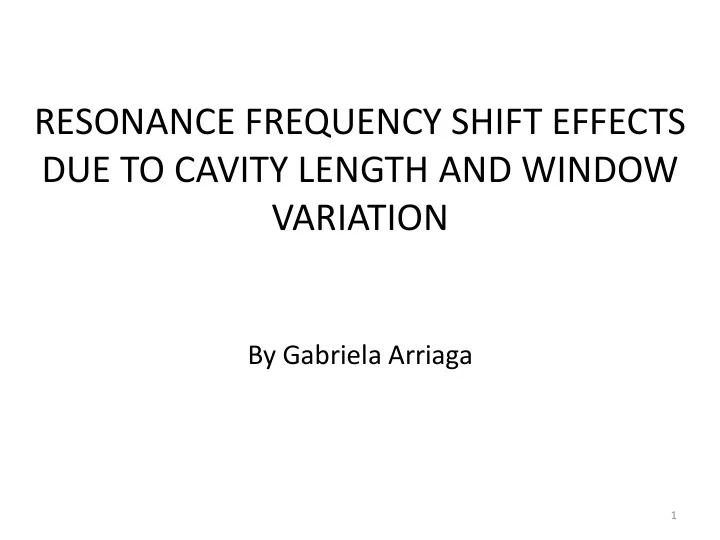

RESONANCE FREQUENCY SHIFT EFFECTS DUE TO CAVITY LENGTH AND WINDOW VARIATION By Gabriela Arriaga 1
Who I am. • Name: Gabriela Arriaga. • Institution: Northern Illinois University. • Major: Physics, junior year. • Fun Fact: I like to crochet toys for children (when there is time)! 2
Who I am (continued) • Have participated in two previous research programs. • Research Rookies. • 2 rounds. • Summer Research Opportunities Program (SROP). • In total, 5 semesters of research experiences (6 including this experience!). 3
Who I am (continued). • Homeschooled for most of my education before college. • Am #4 of 8 children (yes, it is chaotic)! • Am the first child in my family to attend college, and for Physics (Oh, my!) 4
Agenda • Project Description • Goal • Why we care • Methods • Results and discussion • Thanks • Questions 5
Project Goals • Design Radio Frequency (RF) cavities for muon cooling channel (for future muon colliders). • Reduce beam size. • Find a mathematical formula to model and predict cavity shift phenomenon. 6
Why do we care 7
Muon Colliders are smaller than others • It is great to be small. • Can fit anywhere! 8
Change in energy is small That is the hope. 9
What does a muon cooling channel look like? 10
Beginning of the channel 11
The channel! (what we are working on) 12
Methods Primarily • Simulations (lots of Simulations!) using Superfish. • Mathematica. 13
What is Superfish? Superfish is a computer software program created by Los Alamos Laboratory that solves Maxwell's equations for RF, electrostatic, or magnetic cavity problems. Useful due to “ease” of use and speed. 14
What is Mathematica? Software program from Wolfram to manage data and mathematical problems. • Plot neat graphs from data, which can be 2D or 3D. • Model trends. • Ect. 15
Conditions • Bowed cavity windows • The window radius (a) ranged from 2cm – 16 cm [increments of 4 cm] • The bow height of the windows (h) ranged from 0.0 cm – 1.0 cm [increments of 0.2 cm] • Cavity length • Ranged from 5, 10, and 20 cm. • Cavity radius • 17.65 cm 16
Simple sketch of the idea 17
My Efforts • Running simulations for the bowed window • Plot the data and trends in Mathematica. • Calculate other properties for the cavities. Sounds easier than it is! 18
Bowed cavity windows Results 19
First observation( frequency vs. h) • Frequency decreases as h increases. • Looks parabolic. • Same trend for larger cavity lengths.
Second observation (frequency vs a) • Parabolic looking as well. • Critical point or minimum at a= 8 cm. Figure 4: Listplot of frequency change vs bow height. The red dots or for a window radius of 2 cm, green is for 4 cm, blue is for 8 cm, and 0rqnge is for 12 cm 21
Possible model Proposed model: 𝑔 = 𝑔 1 + 𝛽ℎ 2 Where 𝑔 is the change in frequency, α is a constant that is a function of the cavity length and window radius, and h is the height of the bow. Does it work? 22
Working out and testing proposed equation • Solved for 𝛽 with 3x3 matrix, using critical point a=8 cm for symmetry. • Resulting equation: 𝑔 = 𝑔(1 + (3.4226 ∗ 10 6 )ℎ 2 ) . • Standard deviation: ≈ 0.382.128𝐼𝑨 . • Still needs more testing to be sure. 23
Now for the electric field! 24
Parmela Tableplot Figure 1: Table plot output from Parmela SF program. Data used in Parmela was from a simulated cavity with window bow height of 0.2 and window radius of 4 cm. The red line indicates the change in the electric field between the two cavity windows. 25
Parmela Tableplot 2 Table plot output from Parmela of a cavity of length 5 cm, window radius 4 cm, and bow heigth of 1 cm. 26
Tableplot 3 Table plot output from Parmela of a cavity of length 5 cm, window radius 16 cm, and bow heigth of 0.2 cm. 27
Tableplot 4 Table plot output from Parmela of a cavity of length 5 cm, window radius 16 cm, and bow heigth of 1 cm. 28
29
Summary • Mathematical Model 𝑔 = 𝑔 1 + 3.4226 ∗ 10 6 ℎ 2 represents the change in RF with a standard deviation of ≈ 0.2𝑁𝐼𝑨 . • Need to run more simulations to see if there is a more accurate model. 30
Summary • Electric field decreases between the two windows, indicating acceleration. • Larger bow heights have a greater effect on electric field change. • Larger window radii reduce this effect. • More analysis needed to develop a model. 31
Extra Thought and possible next step • Look into multi cell condition. • What will happen if the windows bow at different heights? • If bowing is different as beam passes through the structure, how will electric field and beam be effected? 32
Thanks • Supervisor Katsuya Yonehara, and the rest of the group • Mentors at Northern Illinois University • DOE • SIST committee 33
Recommend
More recommend